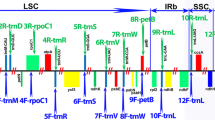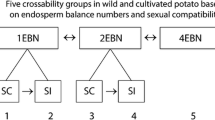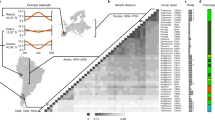Abstract
The Enigma of Solanum maglia in the Origin of the Chilean Cultivated Potato, Solanum tuberosum Chilotanum Group. Landrace potato cultivars occur in two broad geographic regions: the high Andes from western Venezuela south to northern Argentina (Solanum tuberosum Andigenum Group, “Andigenum”), and lowland south-central Chile (S. tuberosum Chilotanum Group, “Chilotanum”), with a coastal desert and 560 km between southernmost populations of Andigenum and Chilotanum. Unlike Andigenum landraces, Chilotanum landraces are adapted to long days and carry a 241 base pair plastid DNA deletion. However, Andigenum and Chilotanum landraces are morphologically similar. We investigated a hypothesis that Chilotanum landraces arose from Solanum maglia, a rare tuber-bearing species found in Chile and Argentina. This hypothesis was formulated first based on morphological analyses of starch grains of extant and preserved (12,500 years before present) S. maglia, and on putative sympatry of extant S. maglia and Chilotanum landraces. Our new starch grain analyses fail to support this hypothesis; we could find no evidence of current sympatric distributions, and S. maglia lacks the 241-bp plastid deletion. However, microsatellite data group all accessions of S. maglia exclusively with Chilotanum, which is supported by our previous observation at the single locus of the waxy gene. These results could be interpreted in various ways, but all explanations have problems. One explanation is that S. maglia is a progenitor of Chilotanum. However, the plastid deletion in Chilotanum but not S. maglia cannot be easily explained. Another explanation is that Chilotanum was formed by hybridization between S. maglia and pre-Chilotanum, but this conflicts with prior cladistic analyses. These new data shed light on aspects of this question and highlight various evolutionary scenarios, but the origin of Chilotanum and the involvement of S. maglia in its origin remain an enigma.



Similar content being viewed by others
Literature Cited
Ames, M. and D. M. Spooner. 2008. DNA from herbarium specimens settles a controversy about origins of the European potato. American Journal of Botany 95:252–257.
Brücher, H. 1963. Das südlichste Vorkommen diploider Kulturkartoffeln in Südamerika auf der Insel Chiloé. Qualitas Plantarum et Materiae Vegetabiles 9:187–202.
——— 1965. Über ein “maritime” Wildkartoffel (Solanum maglia Molina) im argentinischen Anden-Gebirge. Berichte der Deutschen Botanischen Gesellschaft 78:492–498.
Castronovo, A. 1949. Papas chilotas, descripciones y clave para el reconocimiento de muestras de papas recogidas en una excursión al sur de Chile. Revista de Investigaciones Agrícolas 3:209–245 + 8 pl.
Chung, I. and D. Hadziyev. 1980. Tuber and starch characteristics of Alberta grown potatoes. Canadian Institute of Food Science and Technology 13:143–153.
Contreras, M. A. 1987. Germoplasma chileno de papas (Solanum spp). Anales Simposio Recursos Fitogenéticos. Valdivia 1984. Universidad Austral de Chile, International Board for Plant Genetic Resources, 43–75.
Contreras, A., L. Ciampi, S. Padulosi, and D. M. Spooner. 1993. Potato germplasm collecting expedition to the Guaitecas and Chonos Archipelagos, Chile, 1990. Potato Research 36:309–316.
Correll, D. S. 1962. The potato and its wild relatives. Contributions from the Texas Research Foundation. Botanical Studies 4:1–606.
Dillehay, T. D. 1989. Monte Verde: A late Pleistocene settlement in Chile. Volume 1. Palaeoenvironment and site context. Washington and London: Smithsonian Institution Press.
———. 1997. Monte Verde: A late Pleistocene settlement in Chile. Volume 2. The archaeological context and interpretation. Washington and London: Smithsonian Institution Press.
Dillehay, T. D., C. Ramírez, M. Pino, M. B. Collins, J. Rossen, and J. D. Pino-Navarro. 2008. Monte Verde: Seaweed, food, medicine, and the peopling of South America. Science 320:784–786.
Friedman, M. and M. Dao. 1992. Distribution of glycoalkaloids in potato plants and commercial potato products. Journal of Agricultural and Food Chemistry 40:419–423.
Geddes, R., C. T. Greenwood, and S. MacKenzie. 1965. Studies on the biosynthesis of starch granules. Part III. The properties of the components of starches from the growing potato tuber. Carbohydrate Research 1:71–82.
Ghislain, M., J. Núñez, M. del Rosario Herrera, and D. M. Spooner. 2009. The single Andigenum origin of Neo-Tuberosum materials is not supported by microsatellite and plastid marker analyses. Theoretical and Applied Genetics 118:963–969.
———, D. M. Spooner, F. Rodríguez, F. Villamón, J. Núñez, C. Vásquez, R. Waugh, and M. Bonierbale. 2004. Selection of highly informative and user-friendly microsatellites (SSRs) for genotyping of cultivated potato. Theoretical and Applied Genetics 108:881–890.
Grun, P. 1990. The evolution of cultivated potatoes. In: New perspectives on the origin and evolution of New World domesticated plants, ed. P. K. Bretting. Economic Botany (3 Suppl.) 44:39–55.
Haslam, M. 2004. The decomposition of starch grains in soils: Implications for archaeological residue analysis. Journal of Archaeological Science 31:1715–1734.
Hawkes, J. G. 1962. The origin of Solanum juzepczukii Buk. and S. curtilobum Juz. et Buk. Zeitschrift fur Planzenzucht 47:1–14.
——— 1990. The potato: Evolution, biodiversity and genetic resources. Belhaven Press, Oxford.
——— and J. P. Hjerting. 1969. The potatoes of Argentina, Brazil, Paraguay and Uruguay: A biosystematic study. Oxford University Press, Oxford.
Hermundstad, S. A. and S. J. Peloquin. 1985. Germplasm enhancement with potato haploids. Journal of Heredity 76:463–467.
Hizukuri, S. 1969. The effect of environment temperature of plants on the physicochemical properties of their starches. Journal of the Japanese Society of Starch Science 17:73–88.
Hosaka, K. 2002. Distribution of the 241 bp deletion of chloroplast DNA in wild potato species. American Journal of Potato Research 79:119–123.
——— 2003. T-type chloroplast DNA in Solanum tuberosum L. ssp. tuberosum was conferred from some populations of S. tarijense Hawkes. American Journal of Potato Research 80:21–32.
——— 2004. Evolutionary pathway of T-type chloroplast DNA in potato. American Journal of Potato Research 81:153–158.
Johns, T. and J. G. Alonso. 1990. Glycoalkaloid change during the domestication of the potato, Solanum Section Petota. Euphytica 50:203–210.
Liu, Q. 1997. Characterization of physic-chemical properties of starch from various potato and other sources. Ph.D. thesis, Universite Laval, Quebec, Canada.
Mica, B. 1975. Characteristics of the starches of selected potato varieties. 1. Changes in starch content and starch granule size during storage. Starch 27:181–186.
Miller, J. T. and D. M. Spooner. 1999. Collapse of species boundaries in the wild potato Solanum brevicaule complex (Solanaceae, S. sect. Petota): Molecular data. Plant Systematics and Evolution 214:103–130.
Noda, T., S. Tsuda, M. Mori, S. Takigawa, C. Matsuura-Endo, K. Saito, W. H. A. Mangalika, A. Hanaoka, Y. Suzuki, and H. Yamauchi. 2004. The effect of harvest dates on the starch properties of various potato cultivars. Food Chemistry 86:119–125.
Ochoa, C. M. 1990. The potatoes of South America: Bolivia. Cambridge University Press, Cambridge.
Ovchinnikova, A., E. Krylova, T. Gavrilenko, T. Smekalova, M. Zhuk, S. Knapp, and D. M. Spooner. 2011. Taxonomy of cultivated potatoes (Solanum section Petota: Solanaceae). The Botanical Journal of the Linnean Society 165:107–155.
Raker, C. and D. M. Spooner. 2002. The Chilean tetraploid cultivated potato, Solanum tuberosum, is distinct from the Andean populations: Microsatellite data. Crop Science 42:1451–1458.
Rodríguez, F., M. Ghislain, A. M. Clausen, S. H. Jansky, and D. M. Spooner. 2010. Hybrid origins of cultivated potatoes. Theoretical and Applied Genetics 121:1187–1198.
Schmiedische, P. E., J. G. Hawkes, and C. M. Ochoa. 1980. Breeding of the cultivated potato species Solanum x juzepczukii Buk. and Solanum x curtilobum Juz. et Buk. I. Euphytica 29:685–704.
Shannon, J. C., D. L. Garwood, and C. D. Boyer. 2009. Physiology of starch development. Page 894 in J. N. BeMiller and R. L. Whistler, eds., Starch: Chemistry and Technology. Elsevier, Amsterdam.
Singh, J., L. Kaur, and O. J. McCarthy. 2009. Potato starch and its modification. Pages 273–318 in J. Singh and L. Kaur, eds., Advances in Potato Chemistry and Technology. Elsevier, San Diego.
Spooner, D. M. and A. M. Clausen. 1993. Wild potato (Solanum sect. Petota) germplasm collecting expedition to Argentina in 1990, and status of Argentinian potato germplasm resources. Potato Research 36:3–12.
———, A. Contreras, and J. B. Bamberg. 1991. Potato germplasm collecting expedition to Chile, 1989, and utility of the Chilean species. American Potato Journal 68:681–690.
———, K. McLean, G. Ramsay, R. Waugh, and G. J. Bryan. 2005. A single domestication for potato based on multilocus AFLP genotyping. Proceedings of the National Academy of Sciences USA 102:14694–14699.
———, D. Fajardo, and G. J. Bryan. 2007a. Species limits of Solanum berthaultii Hawkes and S. tarijense Hawkes and the implications for species boundaries in Solanum sect. Petota. Taxon 56:987–999.
———, J. Núñez, G. Trujillo, M. Herrera, F. Guzmán, and M. Ghislain. 2007b. Extensive simple sequence repeat genotyping of potato landraces supports a major reevaluation of their gene pool structure and classification. Proceedings of the National Academy of Sciences USA 104:19398–19403.
———, T. Gavrilenko, S. H. Jansky, A. Ovchinnikova, E. Krylova, S. Knapp, and R. Simon. 2010. Ecogeography of ploidy variation in cultivated potato (Solanum sect. Petota). American Journal of Botany 97:2049–2060.
Sykin, A. G. 1971. Zur Frage der Abstammung und der wildwachsenden Vorfahren chilenischer Kulturkartoffeln. Zeitschrijt fur Pflanzenzücht 65:1–14.
Ugent, D. 1970. The potato: What is the origin of this important crop plant, and how did it first become domesticated? Science 170:1161–1166.
——— and M. P. Verdun. 1983. Starch grains of the wild and cultivated Mexican species of Solanum, subsection Potatoe. Phytologia 53:351–363.
———, T. Dillehay, and C. Ramirez. 1987. Potato remains from a late Pleistocene settlement in Southcentral Chile. Economic Botany 41:17–27.
Valkonen, J. P. T., M. Keskitalo, T. Vasara, and L. Pietila. 1996. Potato glycoalkaloids: A burden or a blessing? Critical Reviews in Plant Sciences 15:1–20.
Van den Berg, R. G., J. T. Miller, M. L. Ugarte, J. P. Kardolus, J. Villand, J. Nienhuis, and D. M. Spooner. 1998. Collapse of morphological species in the wild potato Solanum brevicaule complex (Solanaceae: sect. Petota). American Journal of Botany 85:92–109.
Verdun, M. P. 1982. Starch grains: A taxonomic character in Solanum (Tourn.) L., section Tuberarium. M.S. thesis, Southern Illinois University, Carbondale, Illinois.
Acknowledgments
We thank Juan Daniel Montenegro and Jorge Núñez for technical support in the amplification of SSR markers and the analysis of genetic data, respectively. We acknowledge the contributions of Kelly McMillan in the collection of starch granule data.
Author information
Authors and Affiliations
Corresponding author
Additional information
Received 26 September 2011; accepted 20 December 2011.
Rights and permissions
About this article
Cite this article
Spooner, D., Jansky, S., Clausen, A. et al. The Enigma of Solanum maglia in the Origin of the Chilean Cultivated Potato, Solanum tuberosum Chilotanum Group1 . Econ Bot 66, 12–21 (2012). https://doi.org/10.1007/s12231-012-9190-7
Received:
Accepted:
Published:
Issue Date:
DOI: https://doi.org/10.1007/s12231-012-9190-7




